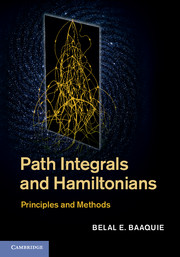Book contents
- Frontmatter
- Dedication
- Contents
- Preface
- Acknowledgements
- 1 Synopsis
- Part one Fundamental principles
- Part two Stochastic processes
- Part three discrete degrees of freedom
- Part four Quadratic path integrals
- Part five Action with acceleration
- Part six Nonlinear path integrals
- 16 The quartic potential: instantons
- 17 Compact degrees of freedom
- 18 Conclusions
- References
- Index
17 - Compact degrees of freedom
from Part six - Nonlinear path integrals
Published online by Cambridge University Press: 05 April 2014
- Frontmatter
- Dedication
- Contents
- Preface
- Acknowledgements
- 1 Synopsis
- Part one Fundamental principles
- Part two Stochastic processes
- Part three discrete degrees of freedom
- Part four Quadratic path integrals
- Part five Action with acceleration
- Part six Nonlinear path integrals
- 16 The quartic potential: instantons
- 17 Compact degrees of freedom
- 18 Conclusions
- References
- Index
Summary
Quantum mechanical degrees of freedom come in many kinds and varieties and are variables that can take values in many different kinds of spaces (manifolds). Compact and noncompact degrees of freedom are two important types. In essence, a compact degree of freedom takes values in a finite range whereas the noncompact take values in an infinite range.
The simplest compact degree of freedom is the Ising spin variable μ that takes two values, namely μ = ±1, and which was studied in Chapters 8 and 9. In Chapters 11 to 16, the noncompact degree of freedom x – takingvaluesonthe real line, that is x ∈[−∞, +∞] – was studied for various models.
Compact degrees of freedom have many specific properties not present for the noncompact case, and the focus of this chapter is on these properties. The degrees of freedom that take values in compact spaces for two different cases are discussed, with each case having its own specific features, as follows:
• A degree of freedom taking values on a circle S1. This case has a nontrivial topological structure that occurs in a wide range of problems, with the simplest case being of a quantum mechanical particle moving on a circle S1.
• A degree of freedom taking values on a two-dimensional sphere S2, a compact space. This degree of freedom can represent a quantum particle moving on a sphere and is the simplest case of a quantum particle moving on a curved manifold.
- Type
- Chapter
- Information
- Path Integrals and HamiltoniansPrinciples and Methods, pp. 385 - 404Publisher: Cambridge University PressPrint publication year: 2014



